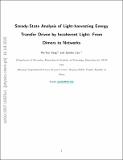Steady-State Analysis of Light-Harvesting Energy Transfer Driven by Incoherent Light: From Dimers to Networks
Author(s)
Yang, Pei-Yun; Cao, Jianshu
DownloadAccepted version (1.421Mb)
Open Access Policy
Open Access Policy
Creative Commons Attribution-Noncommercial-Share Alike
Terms of use
Metadata
Show full item recordAbstract
© 2020 American Chemical Society. The question of how quantum coherence facilitates energy transfer has been intensively debated in the scientific community. Since natural and artificial light-harvesting units operate under the stationary condition, we address this question via a nonequilibrium steady-state analysis of a molecular dimer irradiated by incoherent sunlight and then generalize the key predictions to arbitrarily complex exciton networks. The central result of the steady-state analysis is the coherence-flux-efficiency relation: η = cΣi≠jFijκj = 2cΣi≠jJijIm[ρij]κj, where c is the normalization constant. In this relation, the first equality indicates that the energy transfer efficiency, η, is uniquely determined by the trapping flux, which is the product of the flux, F, and branching ratio, κ, for trapping at the reaction centers, and the second equality indicates that the energy transfer flux, F, is equivalent to the quantum coherence measured by the imaginary part of the off-diagonal density matrix, that is, Fij = 2JijIm[ρij]. Consequently, maximal steady-state coherence gives rise to optimal efficiency. The coherence-flux-efficiency relation holds rigorously and generally for any exciton network of arbitrary connectivity under the stationary condition and is not limited to incoherent radiation or incoherent pumping. For light-harvesting systems under incoherent light, the nonequilibrium energy transfer flux (i.e., steady-state coherence) is driven by the breakdown of detailed balance and by the quantum interference of light excitations and leads to the optimization of energy transfer efficiency. It should be noted that the steady-state coherence or, equivalently, efficiency is the combined result of light-induced transient coherence, inhomogeneous depletion, and the system-bath correlation and is thus not necessarily correlated with quantum beatings. These findings are generally applicable to quantum networks and have implications for quantum optics and devices.
Date issued
2020Department
Massachusetts Institute of Technology. Department of ChemistryJournal
Journal of Physical Chemistry Letters
Publisher
American Chemical Society (ACS)
Citation
Yang, Pei-Yun and Cao, Jianshu. 2020. "Steady-State Analysis of Light-Harvesting Energy Transfer Driven by Incoherent Light: From Dimers to Networks." Journal of Physical Chemistry Letters, 11 (17).
Version: Author's final manuscript